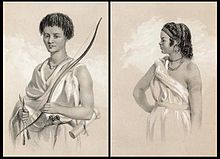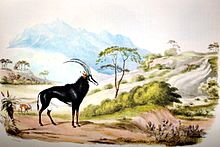William Cornwallis Harris

Sir William Cornwallis Harris (* 1807 , † October 9, 1848 ) was a major in the British East India Company , a hunter and a traveler to Africa.
Life
Childhood and India 1823–1830
He was the son of James Harris of Witterham, Kent , where he was baptized on April 2, 1807. The Royal Navy Captain Robert Harris (1809-1865) was his younger brother. From the age of 14 he attended the Addiscombe Military Seminary, a military school of the East India Company, and in 1823 he went to Bombay as a second lieutenant to the military engineers of the British East India Company . In 1824 he was promoted to lieutenant . This was followed by transfers to Khandesh in November 1825 and to Deesa in October 1830.
South Africa 1836-1837
Because of health problems, Harris was sent to South Africa to recover from a medical commission in March 1836 . He arrived in Cape Town and met the zoologist Andrew Smith , who had just returned from inland. Harris had been an avid hunter since youth and organized a safari . He is considered to be the founder of the safari tradition in Africa. The hunting party started out on ox carts from Algoa Bay and later crossed the Oranje (river) . It went on in a north-easterly direction to the Matabele Kingdom (today's Zimbabwe ). King Mzilikazi was kind to the group and helped them return. The sable antelope observed and described by Harris was recognized as a new species by the Zoological Society of London . Harris left South Africa in December 1837.
He published his experiences in the book Narrative of an Expedition in South Africa . As a talented draftsman, he made animal illustrations in South Africa, which he published as Portraits of the Game Animals of Southern Africa .
India 1838–1841
After his return to India, he resumed his service in Belgaum in January 1838 . In December 1838 he was transferred to Sindh and in December 1840 to the southern provinces.
Ethiopia 1841–1843

In September 1841 Harris was assigned to lead an expedition to Ethiopia to establish relations with the Kingdom of Shewa . He should also collect economic and scientific information and investigate the state of slavery . On November 16, Harris was able to reach a friendship contract with Negus Sahle Selassie . Harris accompanied Selassie on several military campaigns and explored the area around Ankober and Angolalla for over a year . He also experienced the opposition of the Ethiopian Orthodox Tewahedo Church to the social and economic changes that came with the opening up of society. Harris published his observations and experiences in Ethiopia in the book Highlands of Ethiopia . His records are important evidence of Britain's early relationship with Ethiopia.
Next life
In 1843 Harris returned to England and was promoted to major. Because of its success in Ethiopia, he was on 7 June 1844 to Knight Bachelor ( "Sir") beaten . Harris went back to India, took command in Dharward in 1846, Pune in February 1847 and in northern provinces on February 5, 1848. Harris fell ill, developed a high fever, and eventually died near Pune on October 9, 1848.
Publications
- Narrative of an expedition in South Africa, from the Cape of Good Hope to the Tropic of Capricorn in the years 1836–1837 , Bombay 1838 [3] .
- Portraits of the Game Animals of Southern Africa, drawn from Life in their Natural Haunts , London 1840.
- Highlands of Ethiopia, a Narrative of a Mission to the Kingdom of Shoa , London 1844 [4] , [5] .
- Illustrations of the Highlands of Aethiopia , 1845.
Web links
literature
- Henry Manners Chichester: Harris, William Cornwallis . In: Leslie Stephen, Sidney Lee (Eds.): Dictionary of National Biography . Volume 25: Harris - Henry I. , MacMillan & Co, Smith, Elder & Co., New York City / London 1891, pp. 28 - 29 (English).
- Simon Keynes (ed.): Ethiopian Encounters: Sir William Cornwallis Harris and the British Mission to the Kingdom of Shewa (1841-3) . Fitzwilliam Museum, Cambridge 2007, ISBN 978-0-904454-86-4 ; ISBN 0-904454-86-X .
- David H. Shinn, Thomas P. Ofcansky: Historical Dictionary of Ethiopia . 2nd edition, Scarecrow Press, Lanham, MD 2013, ISBN 978-0-8108-7457-2 , pp. 208-209 ( Google Books ).
Individual evidence
- ↑ a b c d e f Henry Manners Chichester: Harris, William Cornwallis . In: Leslie Stephen, Sidney Lee (Eds.): Dictionary of National Biography . Volume 25: Harris - Henry I. , MacMillan & Co., Smith, Elder & Co., New York City / London, 1891, pp 28 - 29 (English).
- ^ William D. Chalmers: On the Origin of the Species homo touristicus. The Evolution of Travel from Greek Spas to Space Tourism . iUniverse , 2011, ISBN 9781450289276 , p. 89 [1] ; Miriam B. Mandel: Hemingway and Africa . Camden House, 2011, ISBN 9781571134837 , p. 88 [2] .
- ↑ Simon Keynes (ed.): Ethiopian Encounters: Sir William Cornwallis Harris and the British Mission to the Kingdom of Shewa (1841-3) . Fitzwilliam Museum, Cambridge 2007, ISBN 978-0-904454-86-4 ; ISBN 0-904454-86-X .
| personal data | |
|---|---|
| SURNAME | Harris, William Cornwallis |
| BRIEF DESCRIPTION | Major in the British East India Company, hunter and traveler to Africa |
| DATE OF BIRTH | baptized April 2, 1807 |
| DATE OF DEATH | October 9, 1848 |
